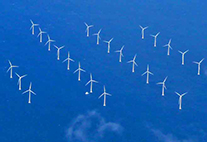Large-scale offshore wind parks offer a cooling effect on land
21 August 2015, by SJ

Photo: UHH
The principle is as old as the windmill: if the wind is strong enough, the blades start turning, converting the moving air’s energy into mechanical energy ...
The principle is as old as the windmill: if the wind is strong enough, the blades start turning, converting the moving air’s energy into mechanical energy. Today’s turbines use the same approach to produce electricity, accounting for more than eight percent of Germany’s energy mix – and that number is growing. There is great potential in wind parks on the ocean, where the wind blows stronger and more consistently than on land, allowing offshore parks to generate more power, more consistently. However, these giant rotors also slow the air currents over the ocean. Could this aspect have an effect on coastal climates? To date, there has been very little research on this potential regional influence.
A large-scale wind park in the German Bight: a scenario for the year 2050
To address that gap, I chose to simulate a scenario for the year 2050 involving 9,000 wind turbines in the German Bight. This would be a true “offshore giant” with a total output of 90 gigawatts, enough to cover the needs of roughly 90 million households. Given that such an enormous wind park wouldn’t leave sufficient room for ship traffic, the example is pure fiction. However, it allows us meteorologists to make accurate assessments concerning the effects of large-scale offshore parks. And today other countries are already constructing huge facilities of their own: China is currently working on a 20-gigawatt offshore park, while the USA plans to build one that will put out more than 50 gigawatts.
During the daytime, the cooling effect would be felt as far as Hamburg
With the help of a computer model, I calculated how the rotors’ movement would affect the temperature and winds during the summer months. Our atmospheric transport and flow model METRAS is based on physical equations that are solved in three dimensions; this allowed me to find values for the wind, temperature and humidity.
The bottom line: intensive wind energy utilization in the German Bight would cause summer temperatures to drop by ca. 0.3 degrees Celsius along Germany’s North Sea coast and in Schleswig-Holstein – both during the day and at night. In the daylight hours even Hamburg, 100 kilometers away, would be cooled by 0.1 degrees. But where does this effect come from?
The heat transfer between the ocean and atmosphere is crucial. If we look at the daytime and nighttime temperatures together, on average the North Sea is warmer than the atmosphere during the summer. Together with the wind, the ocean slightly warms the air. If giant rotors are added to the equation, they reduce the wind speed, weakening the heat transfer between water and air in the process. As a result, the air in the vicinity of the wind park will become somewhat cooler. And the west wind transports that cooler air to Schleswig-Holstein and Hamburg.
But large wind parks also produce a second effect. When the rotors draw energy from the wind and reduce the airflow, the “missing” wind at the height of the rotors is drawn from nearby air layers. As such, the turbines can alter the winds even at great distances. Yet both effects are reversible: my simulation shows that the changes to the temperature and winds dissipate within a few hours of the turbines being shut down.
More information
- Personal profile of Marita Boettcher
- The atmospheric transport and flow model METRAS
- Paper „Influence of large offshore wind farms on North German climate“
